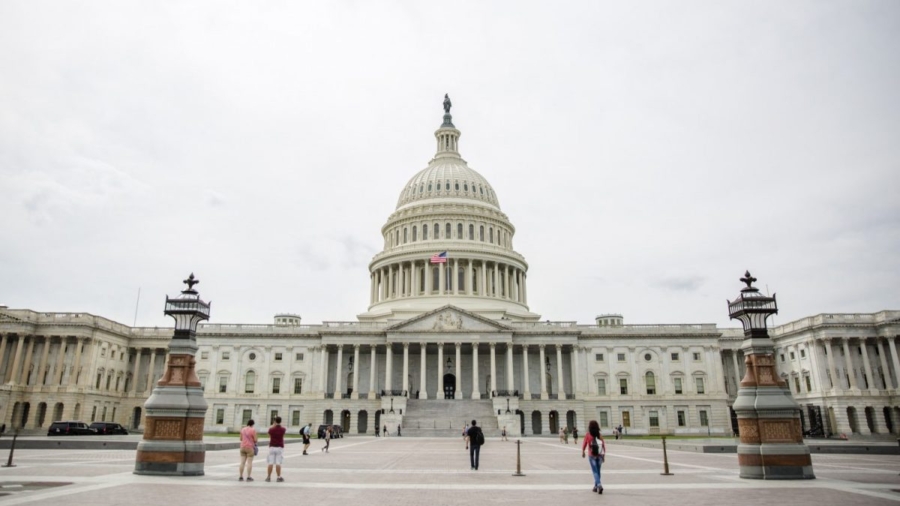WASHINGTON—The Senate passed a privileged resolution to terminate President Donald Trump’s national border emergency by a vote of 59-41 on March 14 under the premise there is no emergency and the president is overreaching.
Twelve Republicans joined all 47 Democrats to pass the measure: Sen. Lamar Alexander (R-Tenn.), Sen. Roy Blunt (R-Mo.), Sen. Susan Collins (R-Me.), Sen. Mike Lee (R-Utah), Sen. Jerry Moran (R-Kan.), Sen. Lisa Murkowski (R-Alaska), Sen. Rand Paul (R-Ky.), Sen. Rob Portman (R-Ohio), Sen. Mitt Romney (R-Utah), Sen. Marco Rubio (R-Fla.), Sen. Patrick Toomey (R-Miss.), and Sen. Roger Wicker (R-Miss.)
The migrants broke through the fence and were repelled with pepper spray smoke pellets. #MigrantCaravan pic.twitter.com/pC8dDFRfOy
— The Epoch Times (@EpochTimes) November 25, 2018
Trump has said he would “100 percent” veto the resolution, which could then only be overridden by a two-thirds majority vote in both houses of Congress.
“I’ll probably have to veto,” Trump said on March 14 before the senate vote. “This is a vote on border security, and it’s a vote on drugs and trafficking and all of that. And I think most Republican senators fully understand that.”

Senate Minority leader Chuck Schumer (D-N.Y.) called the vote a “red letter day,” during a speech before the vote on March 14.
“Democrats and Republicans know the sad truth: The president didn’t call a national emergency because there is one,” Schumer said. Schumer accused the president of trampling on the Constitution because he failed to get funding from Congress.
Senate Majority Leader Mitch McConnell said Trump was “operating within existing law” and that if senators did not like the powers provided to the president under the National Emergencies Act, “then they should amend it.”
The House passed the resolution on Feb. 26 (245 to 182). All Democrats and 13 Republicans voted in favor.

Trump declared the national emergency on Feb. 15, the same day he signed a spending bill in which Congress failed to approve the full $5.7 billion he was requesting for more border wall. Instead Congress approved just less than $1.4 billion.
Through the national emergency, Trump could free up more than $8 billion in funding from other sources, such as the Department of Defense and the U.S. Treasury to allocate to border fencing.
“The massive, surging flow of illegal immigration, trafficking, drugs, and crime threaten the safety and security of all Americans. To confront this urgent national crisis, we’re doing many, many things,” Trump said on March 13. “We’ve got to get the wall up, otherwise it all doesn’t work.”

In the last six months, Border Patrol apprehensions on the southern border have reached twice what they were in all of fiscal year 2017. In February alone, 66,000 people were apprehended crossing the border illegally, with another 10,000 presenting without documentation at ports of entry.
Customs and Border Protection Commissioner Kevin McAleenan said the system is at a breaking point. He said, aside from fixing U.S. immigration laws, the border must be secured—including with around 700 miles of additional fencing—as well as the continuation of work with Mexico and Central American countries to stem the flow of migrants.
We asked a #Texas sheriff: Is the #BorderCrisis manufactured? ????
Interview with Sheriff @AndyLouderback, report by @charlottecuthbo pic.twitter.com/B8eSoqbSv2
— The Epoch Times (@EpochTimes) January 11, 2019
“At the current pace, we are on track to encounter close to one million illegal aliens at our southern border this year,” Department of Homeland Security Kirstjen Nielsen told the House Homeland Security Committee on March 6.
National emergency power was granted to presidents in 1976 and has been used 59 times; most often as a way to place sanctions on other countries, but also for public health (H1N1 virus), and national safety (post 9/11).
Vice President Mike Pence met with Republican senators this week to try to tamp down support for terminating the declaration. Some Republicans are concerned future Democratic presidents could usurp the power of Congress to fund the government and use the emergency declarations to fund their own pet programs.
Reuters contributed to this report.
From The Epoch Times


